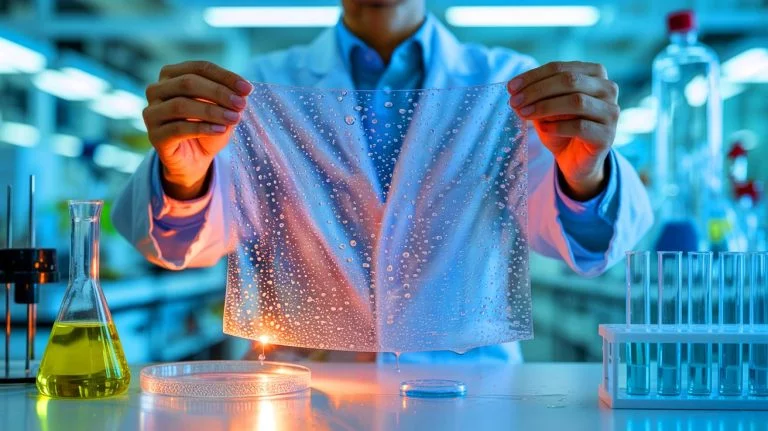| IN A NUTSHELL |
|
A groundbreaking discovery from the University of Toronto promises to disrupt the non-stick coating industry. Researchers have developed a new material that matches the performance of traditional PFAS-based coatings without the associated health and environmental risks. This innovative coating repels both water and oil, similar to existing non-stick materials, but uses only trace amounts of the least harmful PFAS variant. With the potential to revolutionize products from cookware to fabrics, this discovery could mark a significant step forward in sustainable material science.
Silicone Base with PFAS Twist
The foundation of this new material is polydimethylsiloxane (PDMS), widely known as silicone. Silicone is renowned for its biocompatibility, often used in medical devices intended for implantation. Professor Kevin Golovin, who leads the Durable Repellent Engineered Advanced Materials (DREAM) Lab, highlighted the versatility of PDMS. However, its natural properties fall short when compared to the oil and grease repellency offered by PFAS materials.
The breakthrough was achieved by PhD student Samuel Au, who enhanced the performance of silicone through nanoscale fletching. This innovative technique allowed the team to elevate the oil-repellency of the material to levels comparable with traditional PFAS-based coatings.
Nanoscale Fletching for Repellency
Nanoscale fletching emerged as a pivotal technique in this research. By bonding short chains of PDMS to a base material, the team created a structure similar to the bristles of a brush. This configuration was further enhanced by adding the shortest PFAS molecule possible, consisting of a single carbon atom bonded to three fluorine atoms, to the tips of these bristles.
This method mimics the fletching seen on arrows, offering a unique way to boost repellency. Testing with oil droplets demonstrated that the coated fabric achieved a grade of 6 on a standard repellency scale. This rating places it on par with many existing commercial PFAS-based coatings, proving its efficacy in real-world applications.
Low Risk, Commercial Potential
Despite incorporating a PFAS molecule, the team’s approach minimized potential risks by using the shortest possible variant. Professor Golovin emphasized that this molecule does not bioaccumulate, addressing one of the major concerns associated with traditional PFAS use. Regulatory focus has primarily been on banning long-chain PFAS, which are considered more harmful.
The new hybrid material offers the same level of performance as long-chain PFAS but with significantly reduced risks. The team is now looking to collaborate with manufacturers to bring this innovation to the market. Continued research aims to develop an even more sustainable solution that completely eliminates PFAS.
Research and Future Directions
The findings of this study have been published in the journal Nature Communications, highlighting the significant strides made in non-stick technology. The ultimate goal remains to create a substance that rivals or surpasses the performance of Teflon without any PFAS involvement. While this goal has not yet been reached, the current research marks a crucial step in that direction.
Professor Golovin and his team remain optimistic about future developments. The potential applications of this technology are vast, ranging from more sustainable consumer products to safer industrial applications. As research continues, the team is hopeful that they can further refine their techniques and explore new materials.
The development of this new coating opens up exciting possibilities for safer and more sustainable materials. As the research progresses, one key question remains: will this innovation lead to a broader shift in industry standards, paving the way for a future where harmful chemicals are a thing of the past?
Did you like it? 4.6/5 (24)








Wow, this sounds amazing! Are we finally saying goodbye to Teflon? 😊
How soon can we expect to see this new non-stick tech on store shelves?
Is this just another false promise or the real deal? 🤔
Thank you, University of Toronto! This is a game changer for health and environment!
Does this mean we can finally stop worrying about PFAS in our cookware?
What exactly is “nanoscale fletching”? Sounds like something out of sci-fi!
Great news, but how much will it cost compared to Teflon?
Is this tech only for cookware, or could it be used in clothing too?
Finally! My kitchen and my health standards thank you! 🍳
Call me skeptical, but haven’t we heard this kind of thing before?
Does anyone else feel a bit uneasy about the “PFAS twist” part?
Hope this doesn’t end up being another ‘too good to be true’ story.
What are the environmental impacts of this new technology?
Sounds promising, but I’ll wait until I see it in action.
Has anyone tried this yet? Curious to know how it actually performs!
Could this be the end of Teflon’s era? About time! 🎉
How safe is “the least harmful PFAS”? Still sounds a bit worrying.
Finally, a step in the right direction for sustainable kitchenware!
Does this mean I can toss my Teflon pans now? 😅
Will this new tech be easy to clean like Teflon?
Excited to see innovation that focuses on health and safety! 🙌
Is the new non-stick coating dishwasher safe?
Can someone explain “nanoscale fletching” in simpler terms?
Hope this doesn’t introduce new long-term health issues.
Will this affect how food cooks, like browning and crisping?
Great job, but how long will the new coating last?
What’s the catch? There’s always a catch… 😒
Is there a risk of this new material scratching like Teflon does?
Why did it take so long to come up with a safer alternative? 🤷♂️
Thank you to the researchers for pushing boundaries for safer products!
Can this new tech withstand high temperatures like Teflon?
Is this new coating recyclable at the end of its lifecycle?
Would love to know how this performs with sticky foods like eggs!
Finally, a reason to upgrade my cookware set! 🥳
What’s the next step for the researchers after this breakthrough?
More of this please! Who else is ready for a Teflon-free kitchen?
What are the downsides of using silicone-based coatings?
Hope manufacturers adopt this quickly for the sake of our health!
Are there any other health risks associated with silicone?
So excited for a future with safer and more sustainable products! 🌿